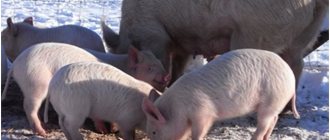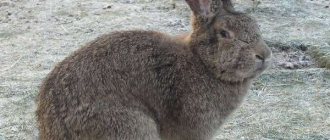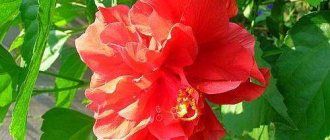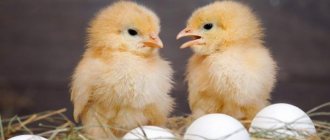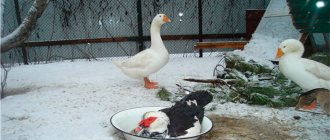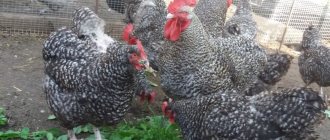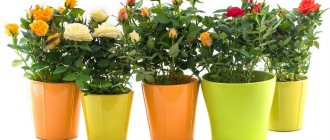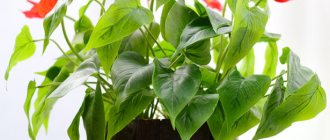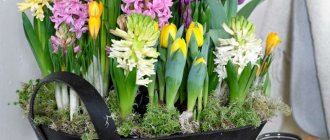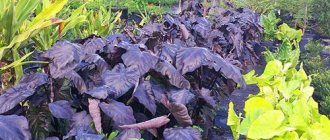Features of keeping pigeons
Pigeons are sociable birds; they urgently need communication with their relatives. They are kept in aviaries or dovecotes, where the birds can freely communicate with their own kind. The breeding of pigeons begins with the preparation of the home, the second step is the purchase of birds. But the main thing is to learn the basics and rules of keeping these birds.
The main rules for keeping pigeons:
- Pigeon housing is spacious and bright, food is complete.
- The room is clean, ventilated, but without drafts. Change the litter weekly, or better when it gets dirty. Wash cages, equipment and the entire dovecote with detergent.
- Birds should have constant access to clean and fresh water, as well as a “pool” - a trough for bathing.
- Artificial lighting is installed in the dovecote to control daylight hours.
- The optimal temperature in summer is up to +25 °C, since pigeons do not tolerate heat well.
- Optimal air humidity is 65-70%. When there is high humidity, birds are prone to infectious and fungal diseases.
- The standard area for keeping pigeons is 0.5-1 square meters. m for two adult birds.
It is especially important to provide pigeons with proper maintenance during the winter. It is necessary to maintain their health and ability to reproduce. If in summer the primary measures are hygiene, disinfection and feeding, then in winter insulation, lighting and additional nutrition are added to this list.
Winter maintenance rules:
- Birds should not be exposed to rain or fog for long periods of time.
- They give a lot of warm water.
- Daylight hours are maintained at 14 hours.
- At the bottom of the dovecote there is ventilation. Entrance doors are insulated, nests are deepened.
- The minimum temperature in the dovecote is minus 10 degrees, minus 25 degrees is allowed for a short time.
- Monthly cleaning and disinfection. Damp places are sprinkled with lime.
- Prevents the appearance of rodents.
- The health of the birds is carefully taken care of. During the molting period, their immunity is weakened, so increased nutrition is necessary. Pigeons are given: grain with a high fat content;
- crushed corn;
- mineral supplements;
- green salad;
- grated carrots.
Caring for domestic pigeons
In order for feathered pets to feel comfortable, they need proper care. The pigeon house needs to be regularly cleared of droppings. Nests with chicks and young animals especially need frequent cleaning. Growing birds leave behind a lot of droppings. Also, the poultry farmer should know that the eggs in the clutch must be clean. If the testicle is at least partially contaminated, then the shell in these places will not allow air to pass through, and the embryo may suffer from this. Light cleaning should be carried out daily, thorough cleaning – once a week, general cleaning – 2 times a year, in spring and autumn in warm weather.
It is necessary to examine your pets every day. This procedure is carried out during feeding. If the bird is in good health, then it quickly flies up to the food and eats with appetite. Sick pigeons peck weakly or do not approach the food at all and sit to the side, closing their eyes and pulling their heads into their shoulders. Sick birds must be immediately isolated.
Very often, balls of droppings form on the claws of birds, which make it difficult for them to move. Such pigeons are picked up and these lumps are carefully removed from their claws. In addition to proper care, winged pets need vitamins. It is also very important what food is used for pigeons at one time or another in their life.
Which breed should I choose?
Pigeons are divided into breeds and species. They differ in external characteristics, behavior and purpose. All pigeons are divided into two large groups:
- Wild. They are demanding in terms of living conditions and care. They are accustomed to a free life, and being kept in a dovecote becomes a painful ordeal for them. Breeding such pigeons should be justified.
- Homemade. They are the ones bred by pigeon breeders. Anyone can master their maintenance and breeding. There are many subspecies in this category - pigeons for exhibitions, for sport, for meat.
Depending on the goals and purpose, pigeons are divided into:
- flight;
- sports;
- decorative;
- meat
Decorative
These birds are kept for personal pleasure or for commercial breeding purposes. Decorative pigeons are distinguished by their unusual shape, color, feathers, they have unusual crests, fluffy tails and other distinctive features.
Popular decorative breeds:
- Barb. Birds with multi-colored, but always monochromatic plumage - from snow-white to dark brown. There are leathery growths around the eyes.
- Curly pigeon. There are curly feathers on the body and wings. The plumage is two-color.
- Brno blower. They have a large, inflated crop, which makes up almost the majority of the pigeon. The legs are long and slender, and the tail is short.
- Peacock dove. They have an erect, bushy tail, reminiscent of a peacock. Coloring – any.
- Saxon priest. There is feathering on the paws, and a crest on the head. The colors are different, but there is always a white mark on the forehead.
Barb pigeons
breed "Curly pigeon"
breed of pigeons "Brno blower"
breed "Peacock pigeon"
pigeons of the breed "Saxon priest"
White peacock pigeons are traditional participants in weddings and other special events. Thanks to their snow-white plumage and bushy tail, they look especially impressive.
When keeping decorative pigeons, it is important to maintain their external beauty. To do this, the dovecote is cleaned and the bedding is changed more often than usual. To ensure beautiful and shiny plumage, birds are provided with a balanced diet.
Sports
These breeds were once called postal breeds. Pigeon mail has not been relevant for a long time, but flying speed competitions are held regularly around the world.
Popular sporting breeds:
- English quarry. These birds are characterized by an upright stance, a large but not deep chest, and a long beak. The structure of their body contributes to the development of high speeds. The eyes have folds of skin that protect the eyes from strong winds.
- Russian postal. Graceful pigeons - they have thin bones and a rounded beak. The wings are long, with bends at the ends - for better maneuverability. Color – from white to dark graphite.
- Belgian postman. Classic breed of racing pigeons. These birds have unsurpassed maneuverability and flight speed. Their head is small, their chest is powerful, and their tail is small.
pigeons of the English Quarry breed
breed "Russian Postal"
Belgian Postman pigeon breed
Carrier pigeons are adopted at the age of one month to get used to the home. A ring is put on the leg of such birds for identification. Pigeons are regularly trained, and they are ready for competitions at 3-4 years of age.
A racing pigeon at the age of 3-4 years can easily cover a distance of 1000 km.
Flight
Flying pigeons have their own style and flight characteristics. They are kept for the sake of a beautiful summer; they are able not only to fly quickly, but also to perform all sorts of tricks - somersaults, rapid falls and take-offs, turns, turns and much more.
Breeds of flying pigeons:
- Thurman Berlin. This breed has a short beak, miniature size and a lively character. They are characterized by high flight speed. Color ranges from white to dark and variegated. The paws have lush plumage.
- Cross monk. They fly at low altitude, their flight style is similar to a dance. They lure other people's pigeons.
- Nikolaevsky pigeon. They fly high, freeze and flutter their wings. They rise almost vertically. The breed is distinguished by long, muscular wings.
pigeon breed "Thurman Berlin"
breed of pigeons "Cross Monk"
"Nikolaevsky pigeon"
A special feature of keeping flying pigeons is regular flights. Birds must fly into the sky every day.
Meat
In many countries, pigeon meat is a popular product. Moreover, the first artificial breeds were bred precisely for the purpose of producing meat - it is especially tasty, with fine fibers.
Popular meat pigeon breeds:
- Modena English. They weigh a lot - 800-900 g, and fly poorly. Including because of the short tail feathers and wings. Color – variegated or plain.
- Roman pigeon. Weigh up to 1 kg. They have strong immunity, so caring for them is as simple as possible.
- King. An American breed that has lost its summer skills. Weight – up to 1 kg. They have a dense, massive body, a small head and a short tail. Color – white. Black, spotted or brown.
- Carnot. Dense and stocky birds of a dark color. They fly poorly and mostly move on foot.
pigeons of the Modena English breed
breed "Roman pigeon"
breed of pigeons "King"
Carnot pigeon
The main thing in keeping meat pigeons is proper feeding. These birds do not fly and do not get food on their own, so humans must fully provide their diet. They are fed cereals, legumes, and oilseeds. They give vitamins, shell rock, charcoal and eggshells. Meat pigeons are kept not in dovecotes, but in enclosures.
What you are not allowed to feed pigeons
What should you not feed pigeons to prevent the birds from getting sick and dying:
• fish contains a lot of easily digestible phosphorus, pigeons are unable to process it; • the bird’s body cannot digest meat products; after eating meat, it may die; • pigeons have few lactic acid bacteria in their bodies; if you give them milk, this can lead to a decrease in calcium and dysbacteriosis; • cheese contains a lot of preservatives and fat; they are contraindicated for birds; • the most forbidden food for pigeons is bread, especially black bread. The fact is that it causes fermentation in the stomach, which can cause digestive problems.
How to buy pigeons for breeding?
When buying pigeons, they take the same number of males and females - so that each bird has a pair. Pigeons take “family ties” seriously - having chosen a partner, they remain faithful to him all their lives.
It is not advisable to buy pigeons in winter. The best time to move in a dovecote is February-March. At this time, birds require special care, which cannot always be fully provided. If you have decided on the breed, all that remains is to select healthy individuals.
Signs of healthy pigeons:
- breathe evenly;
- active;
- have shiny plumage;
- eyes open, shiny;
- The chest should not protrude.
Beginners buy pigeons wherever they can. And this is their big mistake. Experienced pigeon breeders prefer to take pigeons not from the market - from unknown persons, but from a specific dovecote. Moreover, they will first learn as much as possible about it - how pigeons are kept, how they train, and other details.
Chicks
Pigeon chicks
The young are born blind and without feathers. At first, parents are in charge of feeding the babies. But as soon as they grow up a little, they should be provided with proper, high-calorie nutrition and always clean water.
Babies eat a lot, sometimes even more than their parents. This is fine. Be sure to add crushed chalk to the grain.
Adults feed on barley, rapeseed, flax, vegetables and fruits. It should take approximately 50 grams for one voracious beak. It is very important to remember that they only need clean water. In summer, birds fly away early in the morning and return only late in the evening to spend the night and do not need special care.
To raise these wonderful creatures, you need to love them a lot. They quickly get used to people and are very loyal to them.
Arranging a dovecote
When setting up a dovecote, take into account the number of pigeons that will live in it. It is not recommended to build dovecotes near power lines and multi-story buildings.
Perches
Each pigeon should have the opportunity to sit down and rest. To do this, they build perches - perches for birds to sit on. What you need to know when making roosts:
- For each pigeon - 30 cm of perch.
- The material used is smoothly planed wooden painted poles with a diameter of 3 cm. 2x4 cm bars are also suitable.
- Secure the perches at a distance of 30-40 cm from the ceiling.
- Place the perches so that the birds sitting on them do not interfere with each other.
If the breed has long and lush feathers on the wings and legs, then perches are necessary to keep the feathers clean and tidy.
Nests
To make it comfortable for pigeons to breed, nests are installed for them on shelves. The shelves are equipped so that they can serve simultaneously for fallowing and nesting. There should be a separate cell for each bird or pair. They are arranged in several rows. There should be as many nests as there are females in the dovecote, or more.
Features of arranging shelves with nests:
- The cell sizes depend on the size of the rock. Approximate length - 25 cm, width - 35, height - 20 cm. The nests can be open or made in the form of cells - the open part of the cell is covered with a mesh, in which a 10x10 cm hole is left. A small rectangular perch is placed in front of the hole.
- Nests are made in the shaded part of the dovecote - where the females will be calmer. A place lined with sawdust, hay or straw is prepared for the birds.
- Each shelf for the nest is made 5 cm wider than the bottom one - so that excrement does not fall on the inhabitants of the “floor below”.
- Nests 20-25 cm wide and 5-7 cm high are installed in nesting cells. For this purpose, plywood boxes or round plaster nests are used, the bottom of which is covered with straw or sawdust.
Feeders and drinkers
You cannot scatter food on the floor; it must be placed in clean feeders. Moreover, different compartments are used for different feeds. The main condition when creating feeders/drinkers is to prevent debris and bird droppings from getting into them.
The number of feeders and drinkers in the dovecote depends on the number of pigeons. One pigeon should have a minimum approach length of 60 cm; for large breeds this distance is greater. The requirements for feeders are simple; they must be convenient to use - easy to wash, clean and fill. Their material should not be harmful to birds, for example, they should not contain zinc or copper.
To prevent pigeons from polluting water and food, they use devices into which they cannot stand with their feet - only the bird’s head sticks into them. The most convenient for pigeons are automatic feeders and automatic waterers.
Baths
Pigeons, especially in the warm season and during molting, like to take baths. Birds take water treatments in small containers. The easiest way is to buy special baths - they are sold in specialized stores. But if there are suitable containers with a side height of 4-8 cm, you can use them.
In cold weather, pigeons are given water treatments weekly; when nesting begins, twice a week. When the birds bathe, the bath is cleaned so that they do not drink dirty water.
Letok
The entrance is a hole for pigeons to exit. Its size is adjusted to the size of the birds. Typically, the height of the entrances is 10-25 cm, the width is 10-20 cm. One or two entrances are made in the dovecote. For flight breeds, the entrances are located at a height of 1-1.5 m from the floor, for meat and ornamental breeds - 15-20 cm.
The entrances are often made adjustable - they are especially convenient for sporting breeds. A special insert frame is installed in the window, consisting of swinging rods - loose at the bottom. The rods are made from thick wire. The frame also has a special limiter that can be rearranged.
Where you can and cannot keep pigeons
The premises for keeping birds must meet the following conditions:
- The ability for pigeons to communicate with each other . Pigeons need company, so the minimum number of pigeons that should be kept is one opposite-sex pair. However, birds normally need the company of their relatives.
- Pigeons need space . The room must be sufficient in area and volume so that the pigeons have the opportunity to walk and fly from place to place.
- The arrangement of the premises must correspond to their breed . For meat breeds that fly poorly and not high, an aviary is suitable; for flying and sporting breeds, a dovecote is required, equipped with a convenient place for birds to take off and land. For decorative breeds, a cage may also be suitable - but it must be large, and the pigeons from time to time must be released from it for a walk.
- The room should be located in a quiet place where the birds will not be disturbed by the noise of transport or production. It is unacceptable for power line poles and wires to be nearby: flying pigeons can hit them, and, sitting on the wire, the birds will cause a short circuit with a fatal outcome.
- It is highly undesirable to keep pigeons in a residential area . In a confined space, birds will become nervous, conflict and lose health.
- As a last resort, if there are no other options, small numbers of pigeons can be kept on a balcony or loggia in an apartment building, but not in the apartment itself. However, it is better to avoid this: firstly, there will be little space for them on the balcony. Secondly, neighbors who are dissatisfied with droppings, purring or flapping wings can sue - and, from the point of view of the law, they will be right.
Breeding pigeons at home for beginners. How to gain experience
Read
TOP 20 most famous breeds of domestic pigeons
More details
Birds of prey that pigeons are afraid of. Reminder for pigeon breeder
Article
Breed groups of pigeons: what they are and why they are confused with species. TOP best representatives
Read
Conditions
In order for pigeons to be healthy, active, reproduce, and delight their owners with the beauty of their exterior or fattening up of meat (meat breeds), they need to be provided with appropriate living conditions. The well-being and appearance of these birds is influenced by temperature, lighting, the presence of fresh air and the internal arrangement of the dovecote.
Temperature
The temperature in the dovecote affects the health and ability to reproduce. Optimal temperature conditions:
- in winter – 5-7°C;
- in summer – no more than 20°C;
- air humidity - 65–70%.
The minimum permissible temperature in winter is minus 25°C; it should not fall below this mark.
If the birds ruffled their feathers and huddled together, they were cold. You should immediately insulate the dovecote and give the birds warm water. If birds breathe frequently, spreading their wings in different directions, they are hot, you should increase ventilation and place containers with cool water.
In extreme heat, pigeons are not allowed to fly - this is too much stress for them.
Ventilation
A ventilation system is installed inside the dovecote, but drafts are not allowed. At a height of 10-15 cm from the floor, make a hole to allow air to flow in, and cover it with a grate. A hood is made near the ceiling. Doors and bolts are installed on the windows - they are used in cold weather.
If desired, along with natural ventilation, artificial ventilation can be installed. Thanks to the circulation of fresh air, mold, dampness, and infections do not appear in the dovecote.
Lighting
Short daylight hours negatively affect the puberty of young animals - it slows down. But the birds develop better physically. Puberty is also hindered by bright red and orange light.
The optimal length of daylight for pigeons is 13 hours. To control the length of daylight hours, artificial lighting is installed in the dovecote. The dovecote windows are made on the south or southeast side - then there will be more light in the room.
Litter
The dovecote requires bedding. It is made from sawdust, hay, straw, dry peat, thin twigs, and coarse sand. The layer thickness is 5 cm. Thanks to the litter, cleaning is simplified. The litter must be clean. It is completely changed twice a year - in autumn and spring, during disinfection. Damp or rotten litter is changed immediately to avoid the spread of mold and infections.
Aviary for walking
Domestic pigeons for meat and decorative purposes are equipped with an aviary for walking. In the aviary, the birds get used to the outdoors, bask in the sun, and enjoy the fresh air. The enclosure is set up on the ground or above, placing supports. The aviary is also installed on the roof of the dovecote or a suspended structure is made.
Rules for arranging an enclosure:
- the minimum dimensions are 5x3 m, but there must be at least 0.5 square meters per bird. m;
- a roof is equipped to protect against predators;
- the aviary is created using a mesh with cells up to 5 cm - so that wild birds do not fly into it, from which pigeons can catch an infection;
- install double doors so that pigeons cannot fly away;
- the floor is made of concrete or cement - to make it cleaner;
- earthen floors are renewed periodically - they are dug up with a shovel and sprinkled with sand on top;
- a trench is dug around the enclosure, broken glass mixed with earth is poured into it - this is protection against digging that predators can make;
- on the north side the enclosure is covered with plywood or plastic sheets;
- Feeders, drinkers, baths and everything else that is necessary for the daily life of pigeons are installed inside the enclosure.
Additional inventory
To ensure the daily needs of pigeons and maintain the cleanliness of the dovecote and aviary, pigeon breeders need additional equipment:
- bucket;
- broom;
- scoop;
- scraper;
- canister for drinking water;
- litter basket;
- sieve for sifting sand;
- mortar – crush mineral components;
- rakes of different sizes;
- objects used to carry pigeons.
Also in the dovecote there should be a first aid kit with the following composition:
- tweezers;
- scalpel;
- syringe;
- bandage;
- silk threads;
- patch;
- alcohol;
- cotton wool;
- chloramphenicol;
- potassium permanganate;
- boric acid;
- brilliant green and other medications that may be urgently needed to treat birds.
Basics of proper feeding
Principles of feeding pigeons:
- The basis of the diet is barley. Carrots, apples, and potatoes are added to it. Barley can be replaced with pearl barley.
- The daily ration must contain wheat. The rate is increased during molting and feeding of offspring.
- A complete nutritious grain mixture contains millet. This food gives the birds a lot of energy. Millet is especially necessary for sporting breeds when flying long distances.
- There are legumes on the menu. They don’t give a lot of them, so as not to cause obesity. Legumes are necessary during the molting period, during transportation, reproduction and feeding of offspring.
- Hulled oats or oatmeal are added to the grain mixture.
- In the warm season, fresh grass is given.
- It is important to meet your protein needs. If birds do not receive protein, then its absence is compensated for some time by carbohydrates and fats, then the body begins to consume intramuscular protein. But excess protein is also harmful - birds lose their productive qualities. The protein norm in the diet of pigeons is 13-15% of the feed volume.
- Fat-containing grains and eggs are introduced into the diet of meat breeds.
- One individual receives at least 40-50 g of food per day. In winter, nutritional standards are increased.
- To strengthen the immune system, birds are given decoctions of chamomile, thyme and string.
It is prohibited to feed pigeons:
- Fish. The body of these birds does not cope well with phosphorus.
- Meat. The digestive system of pigeons is not suitable for digesting meat products. Birds may even die.
- Black bread. It causes a fermentation process in the stomach.
- Dairy products. There are few lactic acid bacteria in the gastrointestinal tract of pigeons, and the digestion of dairy products is difficult.
- Sweets and products containing oil. The liver of pigeons cannot digest fatty foods. Oil can kill birds. Even sunflower seeds can be damaged by them. If they provide seeds, it is very limited.
- Salt. In large quantities, it is poison for pigeons. To kill a pigeon, 1.5 g of salt is enough. Pigeons cover their need for salt with regular food.
For an adult bird
The feeding regimen of pigeons is determined by:
- time of year;
- the condition of the birds;
- lifestyle (open or closed dovecote).
Catering depending on the time of year:
| Season | Number of feedings | Feeding time, h |
| Winter | 3 |
|
| Summer | 2 |
|
The diet is influenced by the life period of birds:
- Shedding. Lasts from March to November. The share of protein products is growing. A lack of protein leads to delayed molting and the formation of poor-quality plumage - feathers with narrow vanes are formed.
- Reproduction. The period begins in March-April. Fish oil is required - 10 ml per 1 kg of feed. They give mixtures with a high content of protein, amino acids and minerals.
- Oviposition. Begins 7-10 days after mating. Lasts 18-21 days. The food contains many vitamins, amino acids, and minerals. A little greens, potassium iodide (70 mg per 1 kg) and vitamin E (2-3 drops per 1 kg) are added to the food - these substances are necessary for the formation of eggs and high-quality fertilization.
- Winter period. The amount of protein is reduced to reduce the sexual activity of birds. It is advisable to add flaxseed and rapeseed to the daily diet - 4 g per 1 kg. Legumes are excluded, wheat is reduced to a minimum. They give mixtures with boiled potatoes and bran.
Approximate feeding rations for pigeons, taking into account the life period:
| Life period | Peas, % | Vika,% | Wheat, % | Millet, % | Barley, % | Corn, % | Oats, % | Rye crackers, % | Hemp, % | Sunflower, % | Lentils, % | Yeast, % |
| Shedding | 20 | 10 | 10 | 20 | 10 | 10 | 20 | — | — | — | — | — |
| Reproduction | 20 | — | 50 | — | 20 | — | 10 | — | — | — | — | — |
| Oviposition | — | 15 | 30 | 15 | — | — | 15 | 15 | 4 | 5 | — | 1 |
| Winter period | — | — | — | — | 40 | 10 | 40 | — | — | — | 10 | — |
Consequences of vitamin deficiency in female pigeons:
| Substances that pigeons lack | Deficiency Symptoms |
| Vitamin A | cessation of egg production, decrease in hatchability percentage, pipping of non-viable chicks |
| Vitamin B 2 | freezing of embryos, birth of non-viable chicks |
| Phosphorus, calcium, vitamin D | thin shell, no shell on eggs |
For young animals
The growth of young animals depends on the completeness of the diet. Young pigeons are more vulnerable to disease than adults. The incidence rate is reduced if the food contains enough vitamins, minerals and other nutrients.
The first few weeks after leaving their parents, the young animals require a lot of food. They look at the iris, as soon as it becomes the same as that of adult pigeons, the portions are reduced.
Features of feeding young animals:
- The portion in the morning is smaller than in the evening.
- The grain is watered with fish oil.
- In order for the young to grow well, they are fed a mixture of barley, peas and vetch.
- When the pigeons learn to fly, they give half as much wheat - they replace it with peas and vetch, taken in equal parts.
For one individual – 40 g of food. Example of a grain mixture for feeding:
- wheat – 20%;
- vetch – 10%;
- peas – 10%;
- corn – 10%;
- barley – 20%;
- millet – 30%.
As the birds grow, beans are introduced into the diet, reducing the amount of vetch.
Pigeons that are stunted are given an enhanced diet - refined rice, corn grits, millet, feed yeast and fish oil (5 drops per day) are added to the wheat. A 5% glucose solution is added to the water.
Every day the young animals are given succulent green food - 10 g per day for each individual. Potatoes and porridge are used as additives, but they cannot be given without grain - the birds will have indigestion.
Breeding
Domestic pigeons begin to be bred in March. Until this time, the enclosure is prepared, boxes with nests are installed, a pair is selected and preparations are made for the hatching of offspring.
Pair selection
A couple is selected before the beginning of the mating season - in autumn or winter. Principles for choosing a pair for breeding:
- Male and female are of the same breed.
- No flaws in the exterior.
- Both partners must be completely healthy.
- Both birds are strong and energetic.
- The body weight of the female should not exceed the norm.
Obese birds often carry unfertilized eggs, making the egg-laying process more complicated. Emaciated females are also not suitable for reproduction - they are not able to incubate and feed offspring.
Nest preparation
In nature, the male is responsible for arranging the nest. It is he who looks for “building materials” - branches, straws, blades of grass, brings them to the construction site and builds a nest. Females do “design” - they trim the nest, move twigs and feathers from place to place. Give the pigeons woolen threads, fluff, twigs, feathers - let them start building a nest. It takes them about 2-3 weeks to work.
To breed offspring, nesting boxes are installed in the dovecote. It is desirable that there be more of them than the number of pairs - then the birds will be able to choose a nest to their liking, and will not fight over nesting sites.
When pairs are selected, they are placed in the prepared compartments of the nesting boxes and left overnight - the birds will decide whether they are suitable for each other. The couples then spend all their time together.
Incubation period
The female begins to lay eggs two weeks after mating. The dove shows less activity, and an increase in the area near the anus is observed. Young doves can only lay one egg. And not everyone manages to sit through it.
Older individuals lay 2 eggs. Usually, high-quality offspring are produced by experienced females - strong and healthy. It is important to note when the egg is laid. Egg weight – 15-20 g. Hatching duration – 20 days. Moreover, the timing is affected by temperature - the warmer it is, the faster the offspring are hatched. The female and male incubate the eggs alternately.
On the 4th day, the eggs are checked to see if they are fertilized or not. Taking the egg with your fingers, look at it in the light - a dark embryo is visible in the fertilized egg. After 7 days the egg becomes completely dark. Unfertilized eggs are removed, replacing them with dummies so that the birds do not get nervous.
The appearance of the brood
The chick pecks through the eggshell on days 16-19. 12 hours after the first biting, a crack appears on the shell, then a hole. The chick usually appears in the morning. Before it hatches, the nest is cleared of droppings and debris. They do this extremely carefully so as not to irritate the parents - they immediately rush to protect the masonry.
As soon as the chicks appear, they must be examined to see if there are any defects. In healthy chicks, the yolk sac must be completely retracted - otherwise death occurs. Newborn pigeons are naked, wet and blind. Within a few hours, the parents dry them completely and warm them with their bodies. The chick, having dried, is ready to eat food. If he is not given food for more than 24 hours, he dies.
Caring for pigeons
There is no need to show any direct care for the pigeons - the parents do everything themselves.
The task of man is to create favorable conditions for the life of birds. What you have to do is clean, and weekly. The dovecote and nests must be clean.
The first step is to remove the egg shells from the nest. Maintaining cleanliness is necessary to prevent infectious diseases. To destroy microorganisms, regular disinfection is carried out using chemical solutions that are non-toxic to birds.
During harvesting, the pigeons are removed from the box. Detergents must not get into the water and food. First, prepare a soap solution - take 500 g of soap per 10 liters. They use it to wash boxes and perches. Then they begin disinfection - for example, with a bleach solution.
Parents give goiter bird's milk to newborn chicks for 12 days. By the beginning of the second week, the pigeons add grains to it. If one of the parents dies, the entire clutch dies of starvation. The chicks are looking for foster parents. Or they feed themselves - using a syringe. Place a nipple on the syringe and fill it with heated yolk. You can also give babies feed that has been steamed to a pulp.
We recommend reading the article on how to feed a pigeon chick at home.
When artificially feeding, chicks are fed 6 times a day. For 2-3 weeks they are given crushed grain - barley and peas. Sprinkle food with feed chalk. During this period, the chicks begin to learn to drink water.
The goiter determines the satiety of the chick; if it is full, then the bird is full.
Is breeding possible in winter?
Breeding pigeons in winter is complicated due to the slowdown in physiological processes. But pigeons tolerate low temperatures well; if you create suitable conditions for the birds, breeding in winter is possible.
Conditions for breeding pigeons in winter:
- Carefully monitor your health, stopping the first signs of infection in time.
- The nests are deepened to 40 cm.
- The entrance to the dovecote is insulated.
- The temperature should not fall below 10 degrees - otherwise the chicks will freeze.
- Daylight hours are increased to 12 hours due to artificial lighting.
Reproduction
Domestic individuals breed, as a rule, in the spring, at the very beginning of the onset of warmth. Before this process, you need to prepare the nests and the best living conditions for the birds. If the pigeons are wild, then you need to arrange large branches so that they resemble trees, since they usually make nests in the crowns of trees.
Pets build nests in hollows, so you need to prepare special wicker baskets and place them in different places at a long distance. In order for the pigeons to build their own nests, they need a little help. To do this, you need to scatter thin twigs, moss, leaves, and possibly trimmings of woolen threads throughout the dovecote.
After the female lays several eggs, you need to check them for fertilization. To do this, you need to look at the egg against the light. There should be a black dot, and in the middle of the egg there should be veins - this is the embryo. Pigeons take turns incubating eggs, giving each other the opportunity to rest. The eggs hatch for about a month.
Bird health
Pigeons, like all scavenger birds, are active carriers of infectious diseases, including avian influenza. Many diseases are dangerous not only for pigeons, but also for humans. The most dangerous diseases:
- Psittacosis. This is an acute infectious disease. Young animals are especially often affected, and often die if infected.
- Trichomonosis. The causative agent is Trichomonas. Spreads through water. Leads to death.
- Campylobacteriosis. Bacteria that asymptomatically parasitize in the body are called. Treated with antibiotics.
- Listeriosis. Another bacterial disease. Characterized by a long course. There is no effective treatment.
- Tularemia. A bacterial disease with no specific treatment. Use regular antibiotics.
- Pseudotuberculosis. A chronic disease that causes a wide range of symptoms. There is no specific treatment.
And this is only a small part of the diseases that pigeons can suffer from (read what diseases pigeons have here). Due to the fact that people are affected by avian diseases when breeding pigeons, it is necessary to settle the issue with the sanitary and epidemiological station.
To legally keep pigeons in your backyard, you must obtain the following documents:
- Permit – 20,000 rubles.
- Quality certificate – 5,000 rubles.
- Veterinary conclusion – 200 rubles per bird.
The greatest danger to domestic pigeons is wild birds, which is why it is important to prevent their access to the flock.
Pigeon health and influencing factors:
| Positive | Negative |
| dryness, lighting and ventilation | overpopulation |
| vaccination | no quarantine |
| quality food and water | wild birds and rodents |
| vitamins and minerals | birds with chronic diseases |
| feeding mode (flights, walks) | open feeders and drinkers |
| correct breeding selection | untimely breeding |
| drug prophylaxis | stress |
Contents on the balcony
There is enough space on the balcony to accommodate a small flock of pigeons. This is convenient - you don’t have to go to the dovecote, just open the door to the balcony to get into the company of your pets. The disadvantage of this solution is noise, which may not be liked by neighbors.
Features of arranging a dovecote on the balcony:
- The walls of the balcony are covered with plywood or boards so that there are no gaps.
- They make perches and nests for birds, or boxes with compartments.
- The windows should be small, preferably located on the south side.
- The balcony is insulated to prevent dampness and drafts.
- Lighting is provided to increase daylight hours in winter.
- The minimum temperature is 7-10 degrees.
- The dovecote should be ventilated.
- An entrance and exit is arranged in the dovecote.
- The walls of the dovecote balcony are painted in bright colors so that the birds quickly find their home.
Business or just a hobby?
When talking about breeding pigeons, one should distinguish between a hobby and a business. For real pigeon fanciers, this activity is a hobby that takes up all their free time and does not bring in any income. For those who want to create a profitable business, pigeon farming can be a good source of profit.
You can breed for profit both meat pigeons - for meat, and sports, flight, and decorative pigeons - for sale. Features of the “pigeon” business:
- Pigeon meat is very tasty - the taste is comparable to quail meat. It is recommended for dietary purposes, so there is always a demand for it.
- You must have a private house or cottage to set up a dovecote. You can use outbuildings, or build a separate structure.
- If breeds are bred that are not allowed to fly, aviaries are built.
- They buy birds from specialized farms. The cost of one bird is on average 500-1000 rubles.
- The most famous meat breed is King. These birds look more like chickens than pigeons. The weight of one individual is about 2 kg.
- The chicks grow quickly, and within a month they can be sold. Moreover, both carcasses and live pigeons. If non-meat breeds are bred, then naturally only live poultry is sold.
- Those who breed meat breeds find sales of meat in cafes and restaurants. Here, pigeon meat is served as a delicacy, which often becomes the hallmark of the establishment. Having concluded an agreement, you can supply meat at a price of approximately 900-1,200 rubles per 1 kg.
Using Dove Rings
Among experienced pigeon breeders, pigeon rings are widely used. Banding helps to record such important information about a pigeon as breed and age. If desired, you can put any other information on the pigeon rings - city, nickname and other features.
It will be easy for a breeder to distinguish birds from each other if he issues such “passports” to pigeons.
Pigeon rings are divided into open and closed. The first option cannot give an absolute guarantee that the information indicated on it is correct, since such rings for pigeons can be replaced. They can be used in private households. Closed rings are also called generic rings. They are put on eight-day-old birds and are not removed for the rest of their lives. The pigeon's front toes are threaded into the ring, and the back toe is carefully pulled along the metatarsus.
If a pigeon breeder keeps a stud book, then after banding the information from the ring is entered into it, usually the date of birth, color, and the number of the parents’ ring.
Advice from pigeon breeders
Practical advice from pigeon breeders:
- Take measures to eliminate rats and mice. Prevent cats and ferrets from entering. To protect nurseries from rodents, they use a special poison - Deitran. Read the instructions and follow all the instructions - mice and rats will go away for six months.
- If you have some free time, wash the grain feed - you will see how much dirt there is in it. This will reduce the risk of bird infection. Do not seal containers in which dried grain is stored.
- Grain and mineral feeds disinfect microwave ovens well - one minute is enough for disinfection.
- You should not heat the dovecote - the birds will lose resistance to disease. But in cold weather below minus 10 degrees, you need to raise the temperature.
- Do not put lick salt in dovecotes - it is dangerous. The salt will absorb moisture, soften, and birds will begin to peck large pieces - this will cause poisoning and quick death.
- The biggest enemy of pigeons is the dust that comes from dried droppings. It harms breathing and contributes to infection with all sorts of diseases. Therefore, after cleaning the dovecote, be sure to vacuum it, and only then do a wet cleaning.
Breeding pigeons is a specific, troublesome and expensive process. If you decide to engage in this business for profit, first carefully calculate all the costs, assess the risks and your capabilities.
0
0
Copy link

